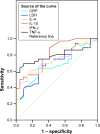Relationships between Th1/Th2 cytokine profiles and chest radiographic manifestations in childhood Mycoplasma pneumoniae pneumonia
- PMID: 27956836
- PMCID: PMC5113916
- DOI: 10.2147/TCRM.S121928
Relationships between Th1/Th2 cytokine profiles and chest radiographic manifestations in childhood Mycoplasma pneumoniae pneumonia
Abstract
Background: Mycoplasma pneumoniae pneumonia (MPP) is one of the most common childhood community-acquired pneumonias, and the chest radiograph usually shows bronchial pneumonia, segmental/lobar pneumonia, or segmental/lobar pneumonia with pleural effusion. The imbalance of Th1/Th2 function after Mycoplasma pneumoniae infection is an important immunological mechanism of MPP. In this study, we aimed to evaluate the correlations between Th1/Th2 cytokine profiles and chest radiographic manifestations in MPP children.
Patients and methods: A total of 87 children with MPP were retrospectively reviewed in this study. According to the chest radiographic manifestations, they were divided into the following three groups: bronchial MPP group, segmental/lobar MPP group, and segmental/lobar MPP with pleural effusion group. Clinical features and changes in Th1/Th2 cytokines were further analyzed.
Results: The incidence of tachypnea and cyanosis was higher in children with segmental/lobar MPP with pleural effusion than in those with segmental/lobar or bronchial MPP. The peak body temperature of segmental/lobar MPP was higher than that of bronchial MPP, and the duration of fever and hospitalization was positively correlated with the severity of MPP. MPP children's chest radiograph showed a relationship with the changes in Th1/Th2 cytokines. Serum interleukin-4, interleukin-10 (IL-10), interferon-γ, and tumor necrosis factor-α (TNF-α) of segmental/lobar MPP were significantly higher than those of bronchial MPP, and serum IL-10 (cutoff value: 27.25 pg/mL) can be used as a diagnostic predictor for segmental/lobar MPP. Serum TNF-α and interleukin-6 of segmental/lobar MPP with pleural effusion were significantly higher than those of segmental/lobar MPP without pleural effusion. Serum TNF-α (cutoff value: 60.25 pg/mL) can be used as a diagnostic predictor for segmental/lobar MPP with pleural effusion.
Conclusion: There were significant correlations between Th1/Th2 cytokine profiles and chest radiographic manifestations in MPP children. Serum IL-10 and TNF-α can be used as an optimal predictor for segmental/lobar MPP and segmental/lobar MPP with pleural effusion, respectively.
Keywords: Mycoplasma pneumoniae pneumonia; Th1/Th2; chest radiograph; cytokine.
Conflict of interest statement
The authors report no conflicts of interest in this work.
Figures




Similar articles
-
Differences of TNF-α, IL-6 and Gal-3 in lobar pneumonia and bronchial pneumonia caused by mycoplasma pneumoniae.Technol Health Care. 2020;28(6):711-719. doi: 10.3233/THC-192011. Technol Health Care. 2020. PMID: 32200365
-
Epidemiology and clinical features of segmental/lobar pattern Mycoplasma pneumoniae pneumonia: A ten-year retrospective clinical study.Exp Ther Med. 2015 Dec;10(6):2337-2344. doi: 10.3892/etm.2015.2818. Epub 2015 Oct 19. Exp Ther Med. 2015. PMID: 26668638 Free PMC article.
-
Clinical Role of Serum Interleukin-17A in the Prediction of Refractory Mycoplasma pneumoniae Pneumonia in Children.Infect Drug Resist. 2020 Mar 12;13:835-843. doi: 10.2147/IDR.S240034. eCollection 2020. Infect Drug Resist. 2020. PMID: 32210598 Free PMC article.
-
Serum Tumor Necrosis Factor-α and Interferon-γ Levels in Pediatric Mycoplasma pneumoniae Pneumonia: A Systematic Review and Meta-Analysis.Can Respir J. 2018 Sep 10;2018:8354892. doi: 10.1155/2018/8354892. eCollection 2018. Can Respir J. 2018. PMID: 30275916 Free PMC article.
-
A meta-analysis of Th1 and Th2 cytokine profiles differentiating tuberculous from malignant pleural effusion.Sci Rep. 2022 Feb 17;12(1):2743. doi: 10.1038/s41598-022-06685-8. Sci Rep. 2022. PMID: 35177742 Free PMC article.
Cited by
-
Rationally designed Mycoplasma gallisepticum vaccine using a recombinant subunit approach.NPJ Vaccines. 2024 Sep 28;9(1):178. doi: 10.1038/s41541-024-00978-x. NPJ Vaccines. 2024. PMID: 39341840 Free PMC article.
-
Cytokine signatures associate with disease severity in children with Mycoplasma pneumoniae pneumonia.Sci Rep. 2019 Nov 28;9(1):17853. doi: 10.1038/s41598-019-54313-9. Sci Rep. 2019. PMID: 31780733 Free PMC article.
-
Effect of montelukast combined with methylprednisolone for the treatment of mycoplasma pneumonia.J Int Med Res. 2019 Jun;47(6):2555-2561. doi: 10.1177/0300060518820412. Epub 2019 May 9. J Int Med Res. 2019. PMID: 31072180 Free PMC article. Clinical Trial.
-
Microbiota Alterations in Lung, Ileum, and Colon of Guinea Pigs with Cough Variant Asthma.Int J Mol Sci. 2024 Feb 19;25(4):2449. doi: 10.3390/ijms25042449. Int J Mol Sci. 2024. PMID: 38397126 Free PMC article.
-
Multidimensional analysis using low-dose computed tomography to evaluate the severity of Mycoplasma pneumoniae pneumonia in children.Quant Imaging Med Surg. 2023 Mar 1;13(3):1874-1886. doi: 10.21037/qims-22-508. Epub 2023 Jan 3. Quant Imaging Med Surg. 2023. PMID: 36915342 Free PMC article.
References
-
- Uehara S, Sunakawa K, Eguchi H, et al. Japanese guidelines for the management of respiratory infectious diseases in children 2007 with focus on pneumonia. Pediatr Int. 2011;53(2):264–276. - PubMed
-
- Guo L, Liu F, Lu MP, Zheng Q, Chen ZM. Increased T cell activation in BALF from children with Mycoplasma pneumoniae pneumonia. Pediatr Pulmonol. 2015;50(8):814–819. - PubMed
-
- Atkinson TP, Balish MF, Waites KB. Epidemiology, clinical manifestations, pathogenesis and laboratory detection of Mycoplasma pneumoniae infections. FEMS Microbiol Rev. 2008;32(6):956–973. - PubMed
LinkOut - more resources
Full Text Sources
Other Literature Sources

